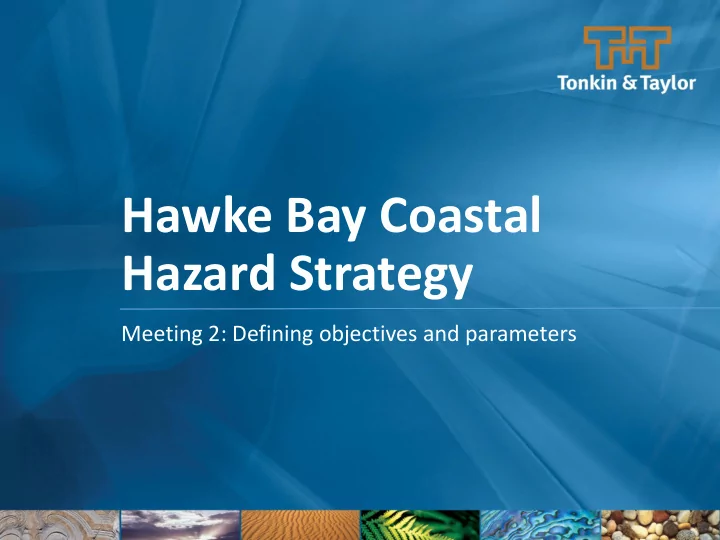

Hawke Bay Coastal Hazard Strategy Meeting 2: Defining objectives and parameters
Objectives • Agree natural hazards to consider • Agree approach – multi-hazard or individual risk, qualitative/quantitative, full risk or specified return periods • Agree return periods (range and number) for each hazard • Agree elements at risk to consider • Agree scale and spatial extent
Refresher!
Natural hazards
Types of Natural Hazards Geologic/ Atmospheric Seismic Hydrologic hydrologic Volcanic Wildfire Global Hail storm Fault ruptures Coastal flooding Debris avalanche Tephra Brush Acid rain atmospheric Hurricane Ground shaking Desertification Expansive soils Gases Forest pollution Lateral Tornado spreading Salinization Landslides Lava flows Grass Global warming Cyclone Liquefaction Drought Rock falls Mud flows Savannah Sea level rise Erosion and Projectiles and lateral Tropical storms Tsunami sedimentation Submarine slides blasts El Nino Catchment Seiches flooding Subsidence Pyroclastic flows Storm surges
Suggested hazards to consider • Coastal erosion (hydrologic) • Storm surge and sea inundation (atmospheric/hydrologic) • Tsunami (seismic) • Effect of sea level rise (global) Additional hazard to consider • Catchment flooding? (atmospheric)
Types of risk analysis
Types of risk analysis
Qualitative risk assessment
Quantitative Risk Assessment
Quantitative – Loss Exceedance Curves Area under this curve gives the Average Annual Loss (AAL)
Annualised loss example Event RP AEP Damage Annualised loss (likelihood) (Consequence) (AEP x Damage) Storm 6/12/2012 - Auckland 60 0.0166667 $ 9,100,000 $ 151,667 Storm 18/05/2005 - BOP 500 0.002 $ 72,000,000 $ 144,000 Earthquake - Christchurch 2500 0.0004 $ 15,000,000,000 $ 6,000,000
Example of risk assessment in risk management Flood mitigation options Without mitigation Scenario I Scenario 2 1200 1000 Average annual risk Risk reduction PRESENT 25.927 0 800 SCENARIO 1 19.315 6.612 Cost $ SCENARIO2 9.7375 16.1895 600 400 200 0 0 0.1 0.2 0.3 0.4 0.5 0.6 AEP
Return periods
Return periods • For risk based assessments need to consider at least 3 return periods for each hazard event • Alternative approach is to choose specific return periods for each hazard
Design risk
Return periods Term AS/NZS 4360 Landslide (Moon & Australian (2004) Wilson, 2004) Geomechanics Society, 2000 Extreme 1 <5 10 Very likely 5-10 Likely 3 50-500 100 Possible 10 500 - 5,000 1,000 Unlikely 30 > 5,000 10,000 Very unlikely 100 >>>5,000 100,000 Ultimate limit states Serviceability limit states Design Type Wind Earthquake working life Normal 1/500 1/500 1/25 50 years Community 1/1000 1/1000 1/25 Normal 1/1000 1/1000 1/25 100 years Community 1/2500 1/2500 1/25
Traditional Hazard Assessment Approach • Deterministic formula providing explicit hazard value • Clarity as to effect of individual parameters and method of derivation • Well tested in New Zealand and internationally • Modified for different coastal types • Allows future modifications of individual components with new data, methods or guidance [ ] CEHZ Beach ST DS LT T SL FS
Probabilistic Hazard Assessment Approach • Probabilistic assessment CEHZ Beach ST DS LT T SL No. of samples
Probabilistic CEHZ Assessment Approach • Probabilistic assessment – Waipu Cove 2115 P 66% P 5% ‘ Likely ’ ‘ Potential ’
Elements at risk and vulnerability
Elements at risk All objects, persons, animals, activities and processes that may be adversely affected by the hazard, directly or indirectly: • Physical elements • Essential facilities • High potential loss facilities • Transportation facilities • Lifelines • Population • Socio-economic aspects • Economic activities • Environmental elements
Scale: Land use the most important spatial attribute
Vulnerability – types of losses
Methods for physical vulnerability assessments Increased computational cost and effort
Expressing vulnerability • Vulnerability indices • Fragility curves • Vulnerability curves • Vulnerability tables
Scale and scenarios
Scale: Land use the most important spatial attribute
Risk reduction or mitigation options Risk reduction Avoidance Structural Eliminate the risk by modifying the Seawalls, levees, dams, building hazard strengthening, etc. Reduce Non-structural Policy/planning Mitigate the risk by modifying the vulnerability to damage and Legal and regulatory disruption Organization structures Transfer Resources Research Outsource or insure and modify the financial impact of hazards Preparedness and contingency planning Early warning Accept Emergency planning Accept and budget for the Information and communication expected damages Education and training Public awareness
Possible scenarios • Divide area into units (wards/suburbs/areas etc) • Carry out hazard mapping for selected hazards and scenarios (3 for current day and 3 for each future sea level rise scenarios) • Risk assessment to identify average annual loss for current day and future scenarios • Identify responses/treatments • Re-run to evaluate cost/benefit of options
Round-up
Check on progress • Agree natural hazards to consider • Agree approach – multi-hazard or individual risk, qualitative/quantitative, full risk or specified return periods • Agree return periods (range and number) for each hazard • Agree elements at risk to consider • Agree scale and spatial extent
Recommend
More recommend